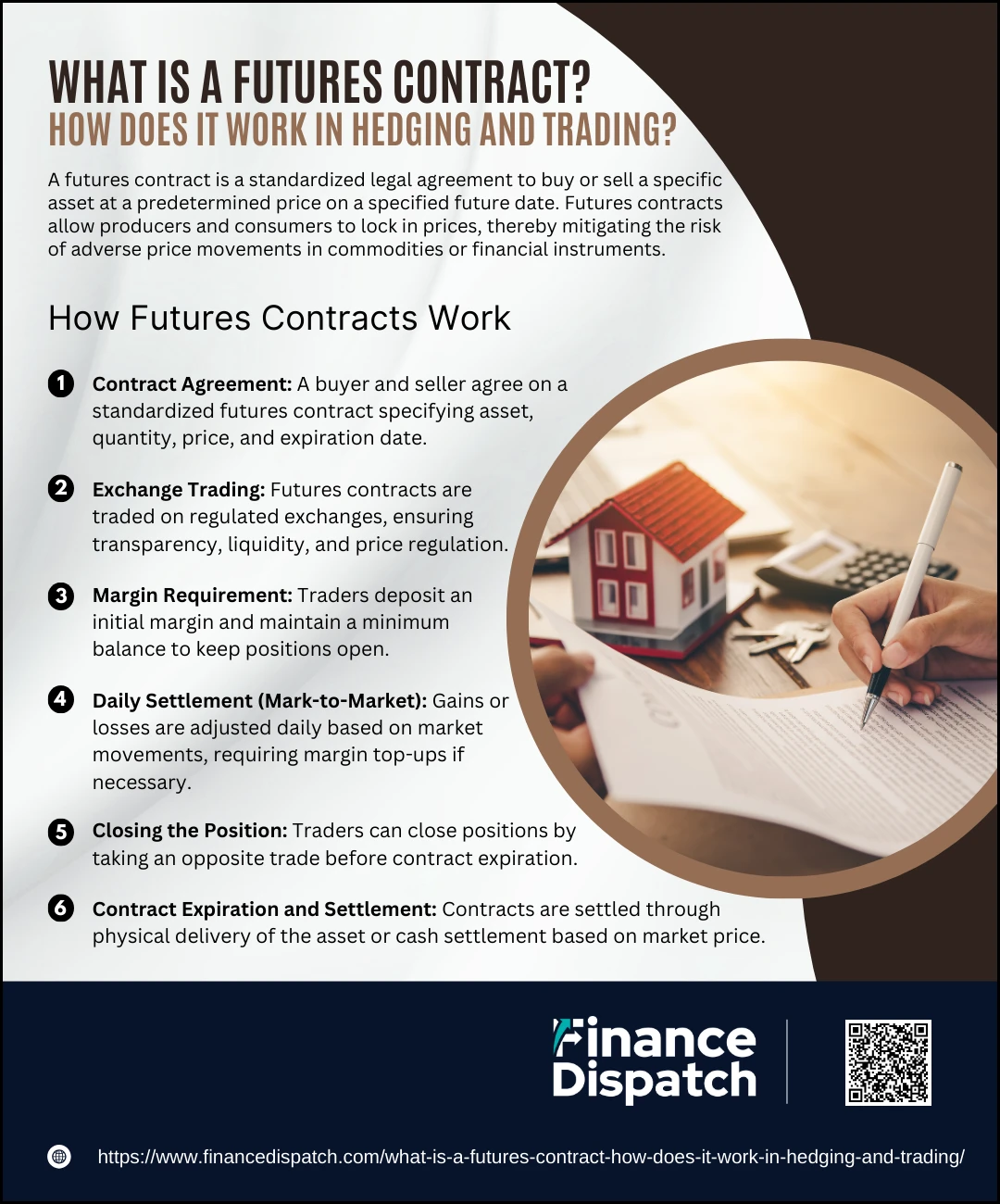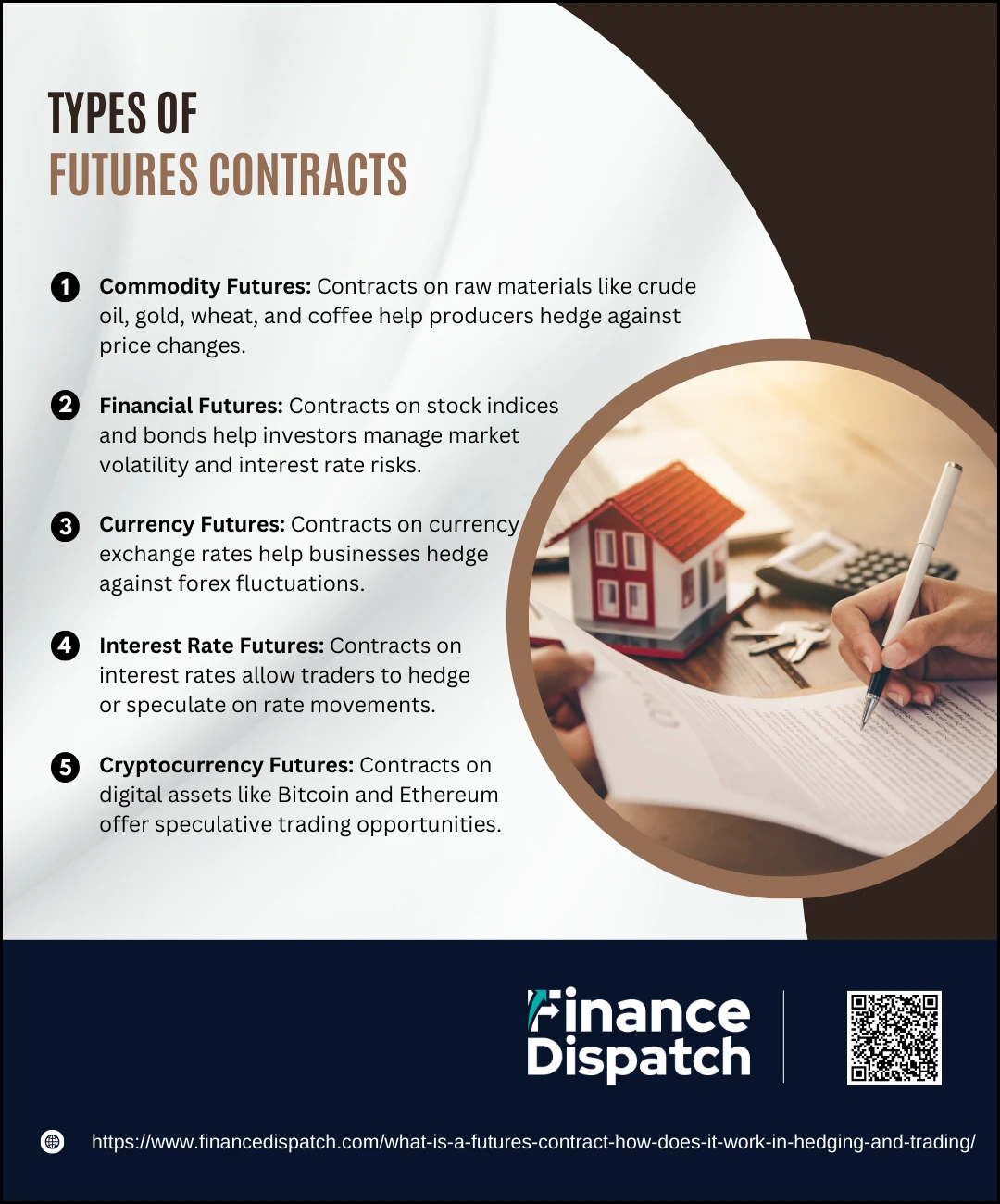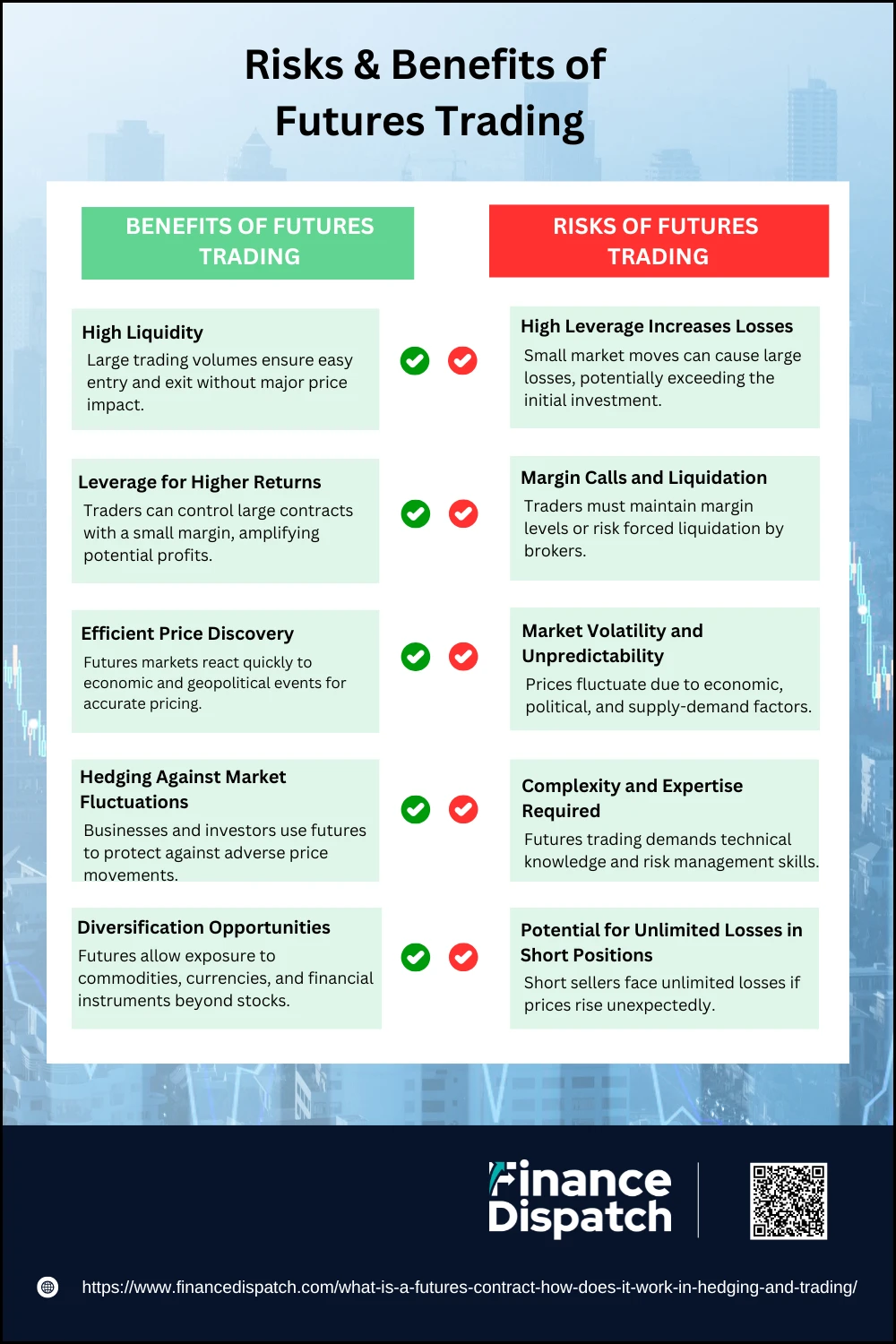Futures contracts play a crucial role in financial markets, allowing investors, traders, and businesses to manage risk and speculate on price movements. A futures contract is a legally binding agreement to buy or sell an asset—such as commodities, stocks, or currencies—at a predetermined price on a future date. These contracts are standardized and traded on regulated exchanges, ensuring transparency and liquidity. Investors use futures for two main purposes: hedging to protect against unfavorable price fluctuations and trading to profit from market movements. While futures offer significant opportunities for both risk management and speculation, they also come with inherent risks, particularly due to leverage. In this article, we will explore how futures contracts work, their role in hedging and trading, and the key considerations for investors looking to use them effectively.
What is a Futures Contract?
A futures contract is a standardized financial agreement between two parties to buy or sell an underlying asset at a predetermined price on a specified future date. These contracts are traded on regulated exchanges and cover a wide range of assets, including commodities like oil and gold, financial instruments such as stock indices and bonds, and even currencies. Unlike spot market transactions, where assets are bought and sold for immediate delivery, futures contracts are legally binding agreements that require execution at the contract’s expiration. The buyer agrees to purchase the asset, while the seller commits to delivering it, regardless of how the market price fluctuates. Futures contracts serve two primary purposes: hedging, where businesses and investors use them to manage price risk, and speculation, where traders seek to profit from price movements. Due to their leverage, futures can amplify both gains and losses, making them a powerful but high-risk tool in financial markets.
 How Futures Contracts Work?
How Futures Contracts Work?
Futures contracts are essential financial instruments that allow buyers and sellers to lock in prices for assets to be traded at a future date. These contracts are widely used in commodity markets, financial markets, and currency exchanges, helping businesses hedge against price volatility and enabling traders to speculate on market movements. Unlike traditional stock trading, futures contracts involve leverage, meaning traders only need to deposit a fraction of the contract’s total value. This amplifies both potential gains and losses, making futures a high-risk, high-reward investment. Below is a step-by-step breakdown of how futures contracts work.
1. Contract Agreement
A buyer and a seller agree on a standardized futures contract that specifies the asset, quantity, price, and expiration date. These contracts are facilitated by exchanges such as the Chicago Mercantile Exchange (CME), Intercontinental Exchange (ICE), and Eurex.
2. Exchange Trading
Futures contracts are traded on exchanges rather than privately between individuals, ensuring transparency, liquidity, and price regulation. A clearinghouse acts as an intermediary, guaranteeing that the contract will be honored by both parties.
3. Margin Requirement
To open a position, traders must deposit an initial margin, which is a percentage of the contract’s total value. A maintenance margin is required to keep the trade open, ensuring that traders have enough funds to cover daily price movements.
4. Daily Settlement (Mark-to-Market)
Every trading day, the futures exchange calculates gains or losses based on market fluctuations and adjusts traders’ account balances accordingly. If losses exceed the maintenance margin, a margin call is issued, requiring additional funds to keep the trade open.
5. Closing the Position
Traders can exit their positions before the contract expires by taking an opposite position. Example: If a trader buys a crude oil futures contract and later sells the same contract, the position is closed, and profits/losses are realized.
6. Contract Expiration and Settlement
If the position is not closed before expiration, the contract is settled in one of two ways:
- Physical Delivery: The underlying asset (e.g., barrels of crude oil or bushels of wheat) is delivered to the buyer. This method is common in commodity markets.
- Cash Settlement: Instead of delivering the physical asset, the contract is settled in cash based on the market price at expiration. This is common in financial futures like stock indices and bonds.
 Types of Futures Contracts
Types of Futures Contracts
Futures contracts exist across various asset classes, allowing investors and businesses to manage risk or speculate on price movements. These contracts cover commodities, financial instruments, and currencies, each serving distinct market needs. Depending on the asset type, futures can be used for hedging price fluctuations or generating speculative profits. Below are the major types of futures contracts traded in financial markets.
1. Commodity Futures
These contracts are based on raw materials and agricultural products. They allow producers and buyers to hedge against price fluctuations. Examples include crude oil, gold, silver, wheat, and coffee futures. Farmers and manufacturers often use them to stabilize costs and revenues.
2. Financial Futures
These contracts derive their value from financial instruments like stock indices and interest rates. Examples include S&P 500 futures, Nasdaq futures, and U.S. Treasury bond futures. Investors use them to hedge against stock market volatility or interest rate changes.
3. Currency Futures
These futures involve the exchange of one currency for another at a predetermined price. Common examples include Euro to USD, Japanese Yen to USD, and British Pound to USD futures. Businesses and traders use them to mitigate risks associated with foreign exchange fluctuations.
4. Interest Rate Futures
These contracts allow traders to speculate on or hedge against changes in interest rates. They are based on financial instruments such as U.S. Treasury bonds and Eurodollars. Banks and financial institutions frequently use them to manage exposure to interest rate movements.
5. Cryptocurrency Futures
These contracts enable traders to speculate on the future prices of digital assets like Bitcoin and Ethereum. They provide a way to gain exposure to cryptocurrencies without directly owning them. Given the volatility of crypto markets, these futures are particularly popular among speculative traders.
How Futures are used in Hedging?
Hedging with futures contracts is a common strategy used by businesses and investors to protect against price fluctuations in commodities, currencies, interest rates, and financial markets. By locking in a future price today, companies can reduce uncertainty and manage financial risk. This strategy is widely used in industries such as agriculture, energy, and manufacturing, where price volatility can significantly impact profits. While hedging helps stabilize costs and revenues, it does not eliminate risk entirely, as market conditions can still change unexpectedly. The table below highlights the key differences between hedging with futures and not hedging.
Hedging with Futures vs. No Hedging
| Aspect | Without Hedging | With Futures Hedging |
| Market Volatility | High exposure to unpredictable price swings | Reduced risk due to fixed prices |
| Price Certainty | Prices fluctuate with the market | Locked-in price for future transactions |
| Profit Stability | Business profits can vary significantly | More predictable financial planning |
| Risk of Loss | Potential for significant financial loss | Losses are offset by futures contract gains |
| Industry Usage | Common in businesses willing to take market risks | Used by producers, manufacturers, and investors to mitigate risk |
How Futures are used in Trading & Speculation?
Futures contracts are widely used by traders and speculators to profit from market price movements without owning the underlying asset. Unlike hedgers, who use futures to reduce risk, speculators embrace market volatility to generate potential gains. They buy futures contracts if they anticipate a price increase (going long) or sell contracts if they expect prices to drop (going short). Since futures trading allows for high leverage, traders can control large positions with a small initial investment, amplifying both gains and losses. Day traders, swing traders, and institutional investors actively trade futures in markets such as commodities, stocks, bonds, and cryptocurrencies. However, speculative futures trading carries significant risks, as rapid price fluctuations can lead to substantial financial losses if the market moves against a trader’s position. Successful futures traders rely on market analysis, risk management strategies, and disciplined trading approaches to navigate the inherent volatility of futures markets.
Futures Trading Mechanics: Margin and Leverage
Futures trading operates on a margin system, allowing traders to control large contract positions with a relatively small initial investment. This system enhances capital efficiency, enabling traders to leverage their funds and potentially amplify returns. However, while leverage can increase profits, it also significantly heightens risk, as even small price movements can lead to large gains or losses. Understanding how margin and leverage work in futures trading is essential for managing risk and avoiding costly margin calls. Below are the key components of margin and leverage in futures trading.
Key Aspects of Margin and Leverage in Futures Trading
- Initial Margin – The minimum amount a trader must deposit to enter a futures contract. This is a percentage of the total contract value and acts as a security deposit.
- Maintenance Margin – The minimum balance required in a trading account to keep a position open. If the account balance falls below this level due to losses, the trader receives a margin call.
- Margin Call – A broker’s request for additional funds when the account balance drops below the maintenance margin. If the trader fails to deposit more funds, the broker may liquidate positions to cover losses.
- Leverage Ratio – Futures trading provides high leverage, meaning traders can control large positions with small capital. For example, a 10:1 leverage ratio means that with $10,000, a trader can control a $100,000 futures contract.
- Mark-to-Market Settlement – Futures contracts are settled daily based on market price changes. Profits and losses are adjusted in real time, requiring traders to maintain sufficient margin levels.
- Risk of Over-Leverage – While leverage can enhance profits, excessive leverage can lead to rapid losses, especially in volatile markets. Managing leverage wisely is crucial for long-term success in futures trading.
 Risks & Benefits of Futures Trading
Risks & Benefits of Futures Trading
Futures trading offers significant opportunities for hedging, speculation, and portfolio diversification, but it also carries substantial risks. The ability to leverage positions with a small margin deposit makes futures attractive to traders seeking high returns. However, this same leverage can lead to large losses if the market moves against a trader’s position. Understanding the risks and benefits of futures trading is essential for making informed decisions and managing financial exposure effectively. Below is a breakdown of the key advantages and disadvantages of trading futures.
Benefits of Futures Trading
1. High Liquidity
Futures markets, especially in commodities, stock indices, and currencies, have high trading volumes, ensuring that traders can enter and exit positions quickly without significantly impacting prices.
2. Leverage for Higher Returns
One of the main attractions of futures trading is leverage, which allows traders to control large contract sizes with a relatively small margin deposit. This enhances profit potential while requiring less upfront capital.
3. Efficient Price Discovery
Futures markets operate almost 24 hours a day, reacting quickly to new information such as economic data, geopolitical events, and corporate earnings reports, making them an effective tool for price discovery.
4. Hedging Against Market Fluctuations
Businesses and investors use futures contracts to protect themselves against adverse price movements in commodities, interest rates, and foreign currencies. For example, an airline company may buy oil futures to lock in fuel costs and avoid exposure to sudden price spikes.
5. Diversification Opportunities
Futures allow investors to diversify their portfolios beyond stocks and bonds by gaining exposure to commodities, currencies, and financial instruments. This helps reduce overall investment risk.
Risks of Futures Trading
1. High Leverage Increases Losses
While leverage enhances profit potential, it also magnifies losses, meaning a small market move against a trader’s position can lead to substantial financial losses, possibly exceeding their initial investment.
2. Margin Calls and Liquidation
Futures trading requires maintaining a minimum margin balance. If the account balance falls below this level due to losses, traders receive a margin call, requiring them to deposit more funds. If they fail to do so, the broker may liquidate positions at a loss.
3. Market Volatility and Unpredictability
Futures prices are influenced by various factors, including interest rates, inflation, supply and demand, and geopolitical events. Unexpected price swings can quickly erase profits or create heavy losses.
4. Complexity and Expertise Required
Unlike traditional investing, futures trading requires a strong grasp of technical indicators, market analysis, and risk management strategies. Traders without adequate knowledge may struggle to make informed decisions, leading to financial losses.
5. Potential for Unlimited Losses in Short Positions
When a trader shorts (sells) a futures contract, expecting the price to drop, they face the risk of unlimited losses if the price rises unexpectedly. Since there is no upper limit to how high prices can go, losses on short positions can be extreme.
Key Differences: Futures vs. Other Financial Instruments
Futures contracts are unique financial instruments that differ significantly from traditional assets like stocks, options, and bonds. While stocks represent ownership in a company and bonds act as fixed-income investments, futures contracts are agreements to buy or sell an asset at a predetermined price on a future date. Unlike options, which give the holder the right but not the obligation to buy or sell, futures require both parties to fulfill the contract upon expiration. Another key distinction is the use of leverage, which allows traders to control large contract sizes with relatively small capital. This increases both profit potential and risk exposure. The table below highlights the key differences between futures and other financial instruments.
Comparison of Futures and Other Financial Instruments
| Feature | Futures Contracts | Stocks | Options | Bonds |
| Ownership | No ownership, only a contract to buy/sell | Represents partial ownership in a company | No ownership, only the right to buy/sell | Lender to an entity (government or corporate) |
| Obligation | Buyer and seller must fulfill the contract upon expiration | No obligation, investor holds until selling | Buyer has the right, but not the obligation, to execute the contract | Bond issuer must repay principal and interest |
| Leverage | High leverage, requires a margin deposit | No leverage unless using margin trading | Leverage available but limited | No leverage, typically a low-risk investment |
| Market Volatility | Highly volatile, prices fluctuate rapidly | Moderate volatility depending on company performance | Can be volatile but losses are limited to the premium paid | Low volatility, relatively stable investment |
| Expiration | Fixed expiration date | No expiration, can be held indefinitely | Has an expiration date, after which it expires worthless | Fixed maturity date when principal is repaid |
| Settlement | Cash or physical delivery at expiration | Immediate settlement upon buying/selling | Cash settlement or asset purchase if exercised | Periodic interest payments with principal returned at maturity |
| Risk Level | High risk due to leverage and price swings | Moderate risk, depends on market conditions | Moderate risk, limited to the premium paid | Low risk, depends on issuer creditworthiness |
Conclusion
Futures contracts are powerful financial instruments that serve both hedging and speculative purposes in various markets, including commodities, stocks, bonds, and currencies. Unlike traditional investments such as stocks and bonds, futures allow traders to leverage their positions, potentially leading to higher profits but also exposing them to significant risks. Businesses use futures to protect against price volatility, while speculators seek to capitalize on market fluctuations. However, the complexity of futures trading, combined with the risk of margin calls and rapid price movements, requires traders to have a strong understanding of market dynamics and risk management strategies. Whether used for portfolio diversification, risk mitigation, or short-term trading opportunities, futures contracts remain an essential tool in modern financial markets. Proper knowledge, disciplined strategies, and careful risk assessment are key to successfully navigating the world of futures trading.



